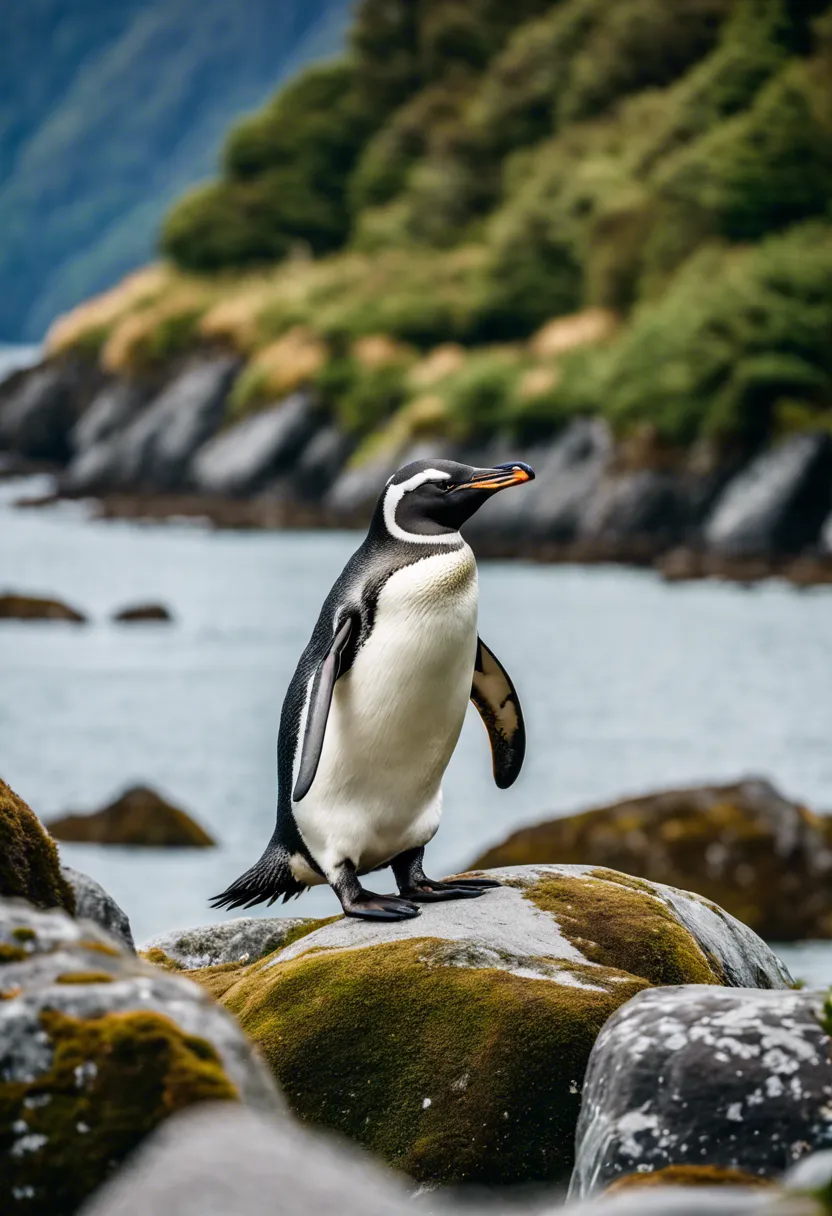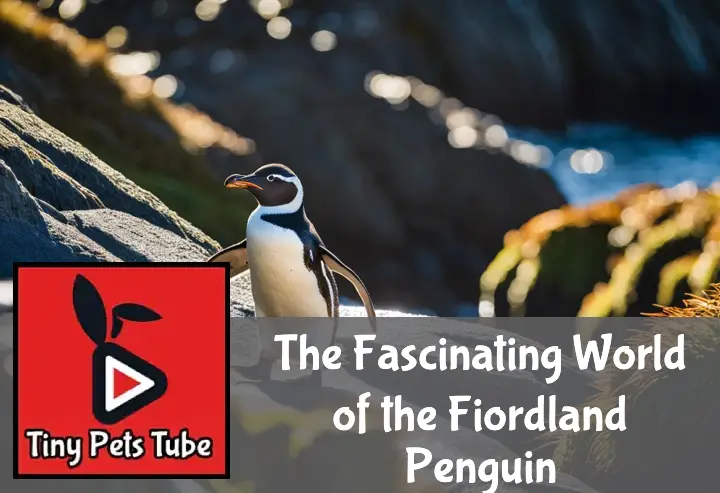Ever found yourself in a deep dive into the world of penguins on Wikipedia? Well, I have! And let me tell you, it’s quite the rabbit hole. One species that caught my eye is the Fiordland Penguin. These little guys are full of surprises!
You see, Fiordland Penguins aren’t your typical Antarctica-loving, Happy Feet dancing birds. Nope! They’re New Zealanders through and through. Stick around as we delve into the fascinating world of these unique feathered friends. “Keep reading about The Fascinating World of the Fiordland Penguin”.
Key Takeaways
- The Fiordland Penguin, also known as Tawaki, is a unique species found in New Zealand.
- They have distinctive yellow crests and a thick stripe of the same color extending from their eyes around the back of their heads.
- Unlike other penguins, they breed in forests, often far from the sea.
- Their diet primarily consists of squid and small fish.
- Tawaki are considered endangered due to habitat destruction and introduced predators. Conservation efforts are ongoing to protect this fascinating species.

The Rare and Remarkable Fiordland Penguin
Meet the Fiordland Penguin, a rare gem in the world of penguins. Known scientifically as Eudyptes pachyrhynchus, this New Zealand native species is one of the most endangered seabirds on our planet. Its unique wildlife characteristics make it a fascinating subject for nature enthusiasts.
Description and Physical Characteristics
The Fiordland Penguin has a distinctive appearance that sets it apart from other crested penguins. It’s medium-sized, with males being slightly larger than females. Their dark blue-black coloration provides excellent camouflage in their coastal habitats.
These penguins are easily identifiable by their yellow eyebrow-like crests, which meet at the back of their heads to form an eye-catching fan shape. Another notable feature is their robust beak, hence the scientific name ‘pachyrhynchus’, meaning ‘thick beak’.
Their bodies are designed for survival in harsh environments. They sport waterproof feathers that keep them dry and warm even when diving deep into icy waters. These adaptations allow them to thrive in some of New Zealand’s harshest coastal ecosystems.
Habitat and Distribution
The Fiordland Penguin calls South Island New Zealand its home, specifically favoring the rugged coastlines of Fiordland and Stewart Island. These areas provide ideal nesting sites for these secretive birds who prefer dense forests over open beaches.
Their geographical distribution plays a significant role in their lifestyle and breeding patterns. During breeding season, they travel to specific locations within their range to mate and raise chicks.
Despite living primarily along the coast, these adventurous birds venture far into the ocean during non-breeding seasons. Their wide-ranging travels contribute to our limited understanding of this elusive species’ full distribution range, making every sighting a special event for birdwatchers and scientists alike!
What Makes the Fiordland Penguin Unique?
The Fiordland Penguin is a unique penguin species with distinctive characteristics that set it apart from its tuxedo-clad cousins. From its breeding habits to survival adaptations, this bird is truly one-of-a-kind.
Breeding and Nesting Habits
When it comes to love, Fiordland Penguins have their own style. They prefer secluded spots for nesting, often in dense forests or steep slopes. Their nests are not your typical penguin igloos but rather a simple scrape in the ground lined with plant material.
The mating rituals of these birds are also quite fascinating. The males perform an elaborate courtship display to woo their mates, which includes loud calls and flipper waving. Once paired up, both parents share the responsibility of incubating the eggs and caring for the chicks. This parental care in penguins is a testament to their strong bond and commitment.
Diet and Hunting Techniques
Fiordland Penguins are skilled hunters with a diet primarily composed of squid and small fish. They hunt in the cold waters off New Zealand’s coast, diving deep into the ocean to catch their prey.
These birds employ specialized hunting strategies that make them efficient predators. They use their sharp beaks and agile bodies to chase down food, showing off some impressive underwater acrobatics in the process. It’s like watching an aquatic ballet where every move is about survival!
Adaptations for Survival
Surviving in harsh conditions requires some serious adaptability skills, and Fiordland Penguins have plenty of those! Their dark plumage helps them blend into rocky shores, providing camouflage against predators.
Their flippers serve dual purposes – powerful swimming aids underwater and balance maintainers on land. These physical traits for survival make them adept at navigating both terrains.
Behaviorally too, they’ve got tricks up their sleeves (or should I say flippers?). They’re known to use predator evasion tactics like hiding in forests and staying motionless when threatened. These survival adaptations make the Fiordland Penguin a true survivor, thriving amidst the challenges of their environment.

The Life Cycle of a Fiordland Penguin

The Fiordland Penguin life cycle is an incredible journey, full of growth and survival challenges. From the moment they’re just eggs to their adult stages, these penguins face a world that’s both fascinating and harsh.
From Egg to Adult: Stages of Development
The egg incubation period is where it all begins for the Fiordland penguin. Nestled in their parents’ warm embrace, these little ones are protected until they’re ready to hatch.
Once hatched, they enter the fledgling stage in penguins. They’re still not quite ready to take on the world yet, but they’re learning fast! Their fluffy down feathers start to be replaced by waterproof ones, preparing them for a life at sea.
Then comes the juvenile phase of Fiordland penguin. This is when things get real! They leave their nests and head out into the big blue ocean. It’s a tough time with lots of growth milestones to hit, but these young ‘uns are up for the challenge.
Finally, after several years at sea, they reach adult maturity. Now fully grown and capable of breeding themselves, they’ve completed their developmental journey – from egg to adult!
Lifespan and Mortality Factors
Now let’s talk about how long our feathered friends can expect to stick around. The average lifespan of Fiordland penguin isn’t too shabby – around 15-20 years if they play their cards right.
But life isn’t always smooth sailing for these guys. Natural predators of penguins like seals or sharks can pose a significant threat. And then there’s environmental impact on lifespan – changes in climate or food availability can make survival tougher than usual.
And we can’t forget about us humans either! Our activities affecting penguins include things like fishing or pollution which can harm these beautiful creatures and shorten their lifespan.
So there you have it, the life and times of a Fiordland penguin. It’s a tough world out there, but these little guys are built to survive!
Threats to the Fiordland Penguin Population
The Fiordland Penguin is a fascinating creature, but it’s not all smooth sailing for these little guys. They face a host of threats that are making life in the wild increasingly challenging.
Natural Predators
When you’re a Fiordland penguin, danger lurks around every corner. The ocean is teeming with predators like sharks and seals, always on the lookout for their next meal. These natural threats are part of the ecosystem balance, but sometimes things can get out of whack.
For instance, changes in predator behavior or population can spell trouble for our feathered friends. If seal numbers skyrocket, it could mean more penguins end up as dinner. It’s a tough world out there in the wild!
Human Impact: Climate Change, Pollution, and Fishing Industry
Humans aren’t helping matters either. Our actions are causing big problems for these little birds. Climate change effects on wildlife are well documented, and Fiordland penguins are no exception.
Rising sea temperatures mess with their food supply and breeding patterns. Pollution threat to Fiordland penguin is another major issue – oil spills can be deadly! And let’s not forget about fishing nets – they can unintentionally catch and kill these beautiful creatures.
But it’s not all doom and gloom! Conservation efforts for penguins are underway to help protect them from these threats. So while we’ve got some serious work to do, there’s still hope for our waddling pals!
Conservation Efforts for the Fiordland Penguin
The Fiordland Penguin is a unique creature that needs our help. Thanks to various conservation efforts, these flightless birds are getting the support they need. But it’s not just about big organizations; individual actions matter too.
Existing Conservation Programs
There are several programs dedicated to the protection of the Fiordland penguin. Organizations such as The Penguin Recovery Project and Habitat Restoration Initiative are leading the charge. They focus on anti-predation measures and habitat restoration, ensuring these little guys have a safe place to call home.
Funding for these initiatives often comes from conservation funds, which rely heavily on donations and grants. These resources enable wildlife monitoring techniques that keep track of penguin populations and their health status. It’s a comprehensive approach that combines different strategies for maximum impact.
How Individuals Can Help
But what can you do? Well, there’s plenty! You can start by adopting eco-friendly practices for wildlife. Reducing plastic use is one way to go about it – less plastic in our oceans means safer environments for our penguin friends.
Volunteering is another great option. Many conservation organizations offer opportunities for individuals to get involved directly. Whether it’s participating in educational outreach or helping with habitat restoration, every bit helps.
Lastly, consider donating to wildlife funds. Your contribution could go towards vital resources like monitoring equipment or anti-predation measures. Remember, when it comes to conservation, every action counts – no matter how small!

To Wrap Up
In a nutshell, the Fiordland Penguin is like that quirky cousin who shows up at family gatherings with wild stories and funky dance moves. These little tuxedo-clad adventurers are as fascinating as they come.
So, next time you’re feeling a bit adventurous yourself, why not dive into more research about these amazing birds? Who knows what other fun facts you might uncover!


